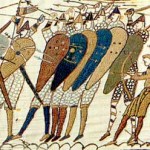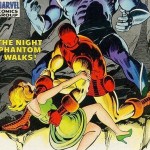With the new Superman movie ‘Man of Steel’ out in the cinemas, I thought it might be interesting to take a look back at the evolution of the source material that’s now dominating the big screen. Evolving from a hand- embroidered tapestry and dating as far back as 1080 AD, comic strips originated thousands of years ago. The earliest known comic strip of sorts, or sequential image storytelling, was the Bayeux Tapestry, a 230-foot long series of imagery and characters depicting the Norman invasion on England, as well as the Battle of Hastings. Before the Bayeux Tapestry, comic strips could even be traced as far back to the prehistoric ages, when cave paintings were first recognised as sequential image storytelling.
Emerging into a marketing tool to increase sales, comic strips were originally used in Sunday newspapers in the late 1800s. First debuting in Hogan’s Alley, Richard F. Outcault’s character, The Yellow Kid, made his first appearance in The New York World in 1895.
With many appearances, the character Yellow Kid gained popularity, and with enough recognition, was able to venture out of the newspapers and dive into his very own comic book, ‘The Yellow Kid in McFadden’s Flats’. Published by G.W. Dillingham Company, the comic was 196 pages long and only cost 50 cents, according to TheComicBooks.com. The Yellow Kid in McFadden’s Flats had the words ‘comic book’ printed on the inside of the back cover, making it the first actual recorded comic book in 1897.
Proceeding after, comic books have claimed their own segments in time and have vastly emerged throughout each comic book era, as we know them today as; the Golden Age, Silver Age, Bronze Age, Iron Age, Dark Age and Modern age.
The Golden Age (1930-1950)
Laying the foundation of epic storytelling between a superhero and villain, Jerome Siegal and Joseph Shuster created Superman in the 1930s. Although this period was not totally dominated by superheroes, with the success of Siegal and Shuster’s Kyrptonian, it saw more and more heroic characters come to the fore, with DC Comics introduced Batman in 1939. Because of growing popularity, other superheroes were created such as Wonder Woman, Captain America, The Flash, and the Green Lantern. Due to the lack of a comic book code, Golden Age comics could be surprisingly dark, as publishers weren’t all that concerned with providing a moral backbone for their characters. This let to the creation of sidekicks such as Robin, who were introduced to provide a little comic relief to the proceedings!
The Silver Age (1956-1970)
Following WWII, superheroes waned in popularity, with westerns, horror, romance and crime stories taking more of the public’s interest. This wasn’t helped by the accusation that comic books were ‘corrupting the youth and creating juvenile delinquency’ – They were the ‘video games’ and ‘video nasties’ of their day! However, the retooling of a number of Golden Age characters was about to change all that, with DC introducing a new version of The Flash in 1956 which saw sales shoot up for our heroes. Riding this success, DC reworked Green Lantern which also proved a hit. Superheroes were back, although, thanks to the newly introduced Comics Code (aimed at stopping this terrible youth corruption…), the stories were a lot lighter in tone than their Golden Age counterparts. Ironically, this rather led to comics now being aimed squarely at kids, with publishers creating lighter fantastical ‘kid friendly’ worlds for their creations to inhabit. Despite the overall silliness of some of the story lines, most of the superheroes you know today were formed and shaped in this period, so owe it a massive debt.
The Bronze Age (1970-c1980)
Unlike the previous 2 ages, there’s not a specific event which heralded in the start of The Bronze Age, but it’s generally considered to have started in the early 70s. Towards the end of The Silver Age, comic book writers started to try and move away from the silliness that had been force upon them by the (now relaxed) Comics Code. Marvel Comics started to create characters with a weakness, and tackled harder social issues, such as racism and drug abuse. Heroes which were flawed, or social outcasts such as Hulk and Spiderman began to emerge. According to RandomHistory.com, “They were persecuted and misunderstood outsiders and spoke directly to public disorientation,” thus creating heightened popularity. However, it’s possible this freedom allowed writers to push too far in the opposite direction. Major characters were killed off. Heroes lost their powers. It was a turbulent time for the comic industry, as writers jumped from one publishing house to another. It did however set a more serious tone, which still continues to this day, but with rising competition other sources of entertainment, such as television, and video games, publishers were looking for new ways to promote their books.
The Iron Age (c1980-c2000)
Stepping out of newspapers and branching off into their own distinctive industry, comic book publishers were able to charge more for comics, as they targeted a loyal customer base through the use of specialized comic book retail outlets. As chains of specialist comic books stores expanded, comic book sales escalated. After 50 years of stories, this period also saw big comic book houses start to ‘retcon’ a number of their properties. Retcon, means retroactive continuity – altering the characters history to consolidate various characters background stories. The most famous example of this would be DC’s ‘Crisis on Infinite Earths‘, which was designed to pull all the various characters they’d amassed over the previous decades into a single cohesive universe. As they bought up smaller comic book companies, ‘crisis events’ are something DC and Marvel would continue to do every 5 years or so as a way of merging their new characters into a cohesive whole.
During this age, there was also a shift towards comics/graphic novels being targeted at an older reader. This period saw the Death of Superman, Bane break Batman’s back in Knightfall, Frank Millar release his epic work The Dark Knight Returns, and Alan Moore publishing the classic Watchmen and V for Vendetta. Darker characters such as Venom and Spawn emerged. With the advent of new, old (and more wealthy) comic book audience, they were became the top collectors’ item, even earning a higher ranking than other favorite collectors’ items, such as stamps and coins. Comic book publishers secured a fresh approach and applied their new marketing concept to advertise comic books as future collectors’ items. As seen in recent history, this method proved to be successful.
The Modern Age (c2000-Present)
The current modern era continues a lot of the Iron Age themes, but with a slight lightening from the previous decades dark plot lines. Reboots and retcons continue, with DC completely resetting it’s entire catalog to issue 1 in 2011 with ‘The New 52’. It’s also seen a rise in independent comic book houses, outside of the big 2 (DC and Marvel). Trade paperbacks – collections of published comic books (as opposed to specifically written single graphic novels) has seen a huge rise in popularity. From the Bayeux Tapestry, to Yellow Kid, and the rise of DC & Marvel, comic books have evolved and adapted to our ever-changing technology age. Today, you can find a digital comic book online or download an app and view it on your smartphone. From classic titles like The Fantastic Four to tv and video game tie-ins like Buffy Season 8, or even Sonic the Hedgehog, new renditions of comic books are now offered in digital editions. More and more frequently, we’re seeing cancelled tv shows using comic books as a way to conclude their stories, or movie directors using them as a way to flesh out a film’s back-story. Whether in digital format, or in a traditional paper based medium, comic books are still grasping the imaginations of adults and children alike.
So what will comic books look like in 50 years, a hundred years? Imagine how unlikely something like the internet would have seemed to early artists in the 1900s. Now imagine technology accelerating in the next century… Who knows, maybe humans will inhabit avatars in their own special comic book virtual realities! I call dibs on Geekman. ;)



